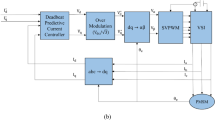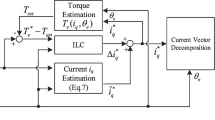Abstract
Magnetic bearings are widely used in fields such as fluid machinery, aerospace, and marine vessels due to their properties of non-mechanical contact. Due to errors in manufacturing and assembly, unbalanced forces will be generated when the magnetic suspension rotors rotate, especially at high speed, which can easily cause strong vibration of the equipment. The control compensation algorithm of minimum displacement for the rotor is to adjust the control current of the magnetic bearing based on speed and unbalanced quantity, so that the rotor rotates around its centre of the geometric as much as possible, in order to reduce rotor displacement vibration and ensure the reliable and safe operation of the equipment. However, owing to the presence of speed changes and phase lag, it is necessary to continuously and repeatedly calculate the unbalanced compensation coefficient, which increases the computational complexity and affects the control effect of the magnetic suspension rotor. Therefore, this paper proposes a method based on LMS (Least Mean Square) and polynomial fitting to calculate the unbalanced compensation coefficient, obtaining the compensation amplitude and phase of the unbalanced vibration of the magnetic suspension rotor at different speeds, solving the problem of active unbalanced vibration control for the magnetic suspension rotor at any speed, and providing guarantee for the application of the magnetic suspension rotor in high-speed rotating machinery.














Similar content being viewed by others
Data availability
Enquiries about data availability should be directed to the authors.
References
Hu, Y., Yang, K., Wu, H., et al.: Critical vibration and control of the Maglev high-speed motor based on μ-synthesis control. Sensors 22(22), 8692 (2022)
Bangcheng, H., Zan, H. T., Zheng, W., Shiqiang, Z.: Design, optimization and test of RHMB considering dynamic characteristics. Int. J. Mech. Sci. 238 (2023)
Fang, J. C., Zheng, S. Q., Han, B. C.: AMB vibration control for structural resonance of double-gimbal control moment gyro with high-speed magnetically suspended rotor. Ieee-Asme Trans. Mechatronics. 18(1), 32–43 (2013).
Zhang, W.Y., Zhu, P.F., Cheng, L., et al.: Improved centripetal force type-magnetic bearing with superior stiffness and anti-interference characteristics for flywheel battery system. Int. J. Precis. Eng. Manufact. Green Technol. 7(3), 713–726 (2020)
Shrivastava, A., Mohanty, A. R.: Identification of unbalance in a rotor-bearing system using Kalman filter based input estimation technique. J. Vibrat. Control. 26(11–12) (2016).
Ranjan, G., Tiwari, R.: On-site high-speed balancing of flexible rotor-bearing system using virtual trial unbalances at slow run. Int. J. Mech. Sci. 183(1) (2020).
Wang, Y., Liu, K.: Vibration suppression of magnetic suspension flywheel based on variable step LMS Method. J. Dyn. Control 20(3), 77–82 (2022)
Dongju, C., Dong, L., You, Z., et al.: Research on vibration suppression of gas spindle based on piezoelectric ceramics. Piezoelectricity Acousto Opt. 43(05), 670–675 (2021)
Yunqiang, L., Cuicui, C., Xiangchun, C., et al.: Research on torsional vibration characteristics of shaft systems based on magnetorheological dampers. J. Beijing Inst. Technol. 40(11), 1174–1181 (2020)
Jian, X.: Research on active vibration control of rotary systems based on magnetorheological fluid dampers. Beijing University of Chemical Technology (2015).
Song, T., Han, B., Zheng, S., et al.: Variable polarity LMS feedback unbalanced compensation for magnetic suspension rotor based on minimum displacement. Vibrat. Shock 34(07), 24–32 (2015)
Yoon, S.Y., Long, D., Lin, Z.: An output regulation approach to rotor auto-balancing in active magnetic bearing systems with input delay. In: IEEE International Conference on Advanced Intelligent Mechatronics. IEEE, New York (2016).
Jian, Z., Huachun, W.: Active unbalance compensation of a maglev rotor with two active magnetic bearings based on the LMS algorithm and the influence coefficient method. Mech. Syst. Signal Process. 3(7) (2022).
Zhou, T., Chen, L., Zhu, C., et al.: Unbalance compensation of maglev high-speed motor based on adaptive variable step size minimum mean square algorithm. Trans. China Electrotech. Soc. 35(09), 1900–1911 (2020)
Xiang, M., Wei, T.: Autobalancing of high-speed rotors suspended by magnetic bearings using LMS adaptive feedforward compensation. J. Vib. Control 20(9), 1428–1436 (2014)
Jiang, K., Zhu, C., Chen, L.: Unbalance compensation by recursive seeking unbalance mass position in active magnetic bearing-rotor system.. IEEE Trans. Industrial Electron. 62(9) (2015).
Wu, H., Zhou, J., Ji, L.: Unbalance compensation of magnetic suspension rotor based on single-phase coordinate transformation. J. Zhejiang Univ. (Engineering Edition) 54(05), 963–971 (2020)
Mao, C., Zhu, C.: Unbalance compensation for active magnetic bearing rotor system using a variable step size real-time iterative seeking algorithm. IEEE Trans. Industrial Electron. 99, 1–1 (2017)
Chen, Q., Liu, G., Han, B.: Unbalance vibration suppression for AMBs system using adaptive notch filter. Mech. Syst. Signal Process., 93 (2017).
Cui, P.L., Liu, Z.Y., et al.: harmonic vibration force suppression of magnetically suspended rotor with frequency-domain adaptive LMS. IEEE SENSORS J. 30(3) (2020).
Zhou, J., Zuo-Xi, N.I.: Identification method for stiffness and damping of magnetic bearings based on rotor unbalance responses. J. Vibrat. Shock 32(3), 29–34 (2013)
Hu, Y., Zhou, Z., Jiang, Z.: The basic theory and application of magnetic bearings. Machinery Industry Press, (2006)
Yang, G.: Fundamentals of Mechanical Vibration. China Petrochemical Press, (2012)
Gao, H.: Research on unbalanced vibration compensation of active magnetic bearing system. Nanjing University of Aeronautics and Astronautics (2011)
Yang G.: Practical Technology for Dynamic Balancing of Rotors. China Petrochemical Press, (2012)
Funding
The project was supported by the National Key R&D Program of China with Grant Number 2018YFB2000103.
Author information
Authors and Affiliations
Corresponding author
Ethics declarations
Conflict of interest
The authors declare that they have no conflict of interest.
Additional information
Publisher's Note
Springer Nature remains neutral with regard to jurisdictional claims in published maps and institutional affiliations.
Rights and permissions
Springer Nature or its licensor (e.g. a society or other partner) holds exclusive rights to this article under a publishing agreement with the author(s) or other rightsholder(s); author self-archiving of the accepted manuscript version of this article is solely governed by the terms of such publishing agreement and applicable law.
About this article
Cite this article
Wu, H., Yang, T., Xiao, W. et al. Online active vibration control for the magnetic suspension rotor using least mean square and polynomial fitting. Nonlinear Dyn 112, 7029–7041 (2024). https://doi.org/10.1007/s11071-024-09439-5
Received:
Accepted:
Published:
Issue Date:
DOI: https://doi.org/10.1007/s11071-024-09439-5




